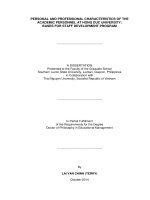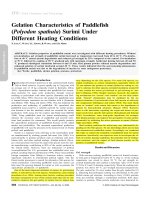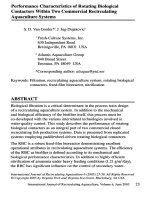Spawning characteristics of babylonia areolata
Bạn đang xem bản rút gọn của tài liệu. Xem và tải ngay bản đầy đủ của tài liệu tại đây (3.94 MB, 5 trang )
Phuket Marine Biological Center Special Publication 25(7): 151-165 (2001)
767
Spawnitg characteristics of Babylonia areolata (Neogastropoda:
Buccinidae)
Hua Ngoc Phuc, Nguyen Thi Xuan Thu, Mai
& Kieu Tien Yen
Dry Minh,
Phan Dang Hung
& T.Y.Kieu. 2001. Spawning
characteristics of B abylonia areolata (Neogastropoda:Buccinidae). - Phuket Marine
Biological Center Special Publication 25(1): 167-165.
Hua,N.P., T.X.T.Nguyen, D.M.Mai, D.H.Phan
The Babylon snail (Babylonia areolata) is a gonochoristic, internally fertilized
gastropod. Sex ratio of snails with a length of 35-50 mm was 1:1.3 (M:F) and 1:
2.6 in the largest snails. Seven months after hatching, snails had reached 35-42
mm in length and began to spawn. Adult snails kept in cement pond deposited
egg capsules throughout the year with spawning peaks in March and July.
Vasiform transparent egg capsules were laid during the night and attached to
the sandy bottom or coarse substratum in pond. Each breeder deposited from
18 to 75 (average 38) egg capsules. Egg capsule measured 30.6 x 9.9 mm on
average and contained an average of 743 eggs in jelly-like fluid. About 6 days
after spawning, bilobed veliger larvae hatched out. Veliger larvae spent 12-1,4
days of free swimming stage and metamorphosed to crawling juveniles after
76-78 days. Average fertilization and hatching rates were 83 % and 90 "/"
respectively.
I Kieu
Tien Yen. The Third Research Institute for Aquaculture (RIA 3), 33 Dnng Tat Street,
Hua Ngoc Phuc, Nguyen Thi Xusn Thu, Mai Duy Minh, Phan Dang Hung
NhaTrang, Vietnam.
E-mqil Nguyen Thi Xuan Thu:
E-mail Hun Ngoc Phuc:
INTRODUCTION
Babylonia areolnta has high economical value
as seafood. In Vietnam, babylon snails inhabit
the coast of Thanhhoa, Nghean,
FIue,
Quangngai, and are particularly abundant in
Binhthuan. At present, the amount of babylon
snails harvested from nature is decreasing
rapidly due to increasing demands from
from the littoral region of Phanthiet. The mean
length was 70.5 mm and the weights1..g g. The
snails were kept in outdoor cement pond at a
density of 10 individuals per m2. Sea water
was changed daily from 50 to B0%. The snails
were fed fish, bivalves and cuttlefish at a rate
of 5-B % of their total body weight. The
MATERIALS AND METHODS
fecundity of snails was observed monthly by
looking at separate clusters of egg capsules.
The size of egg capsules was measured and
the numbers of eggs in randomly-selected
capsules were counted. The fertilization and
larval development were observed under a
microscope during the period of incubation.
The newly hatched veliger larvae were
reared in 0.7-1.0 m3 cement ponds and fed on
mixed microalgae. Larval growth was noted.
The snail breeders were collected naturally
When larvae metamorphosed into the
domestic and foreign markets. Therefore,
studies related to breeding biology and larval
development are essential for sustained
utilization of this stock. Evolving techniques
for mass seed production would encourage
fishermen gradually to take up large-scale
commercial culture.
762
Tropical Marine Mollusc Programme
crawling stage, fish and bivalve flesh was
given as food. 50-80 % of the water was
changed daity. Snails were cultured at a
density range of 3000-5000 individuals per m2.
RESULTS
Externql shell and morphological characteristics. Spirally conical regular shells of B. areolnta are
step-like forms. The height of the spire is equal
to half the total shell length. They show
characteristic colour patterns consisting of
brownish or violet parallelogram-shaped
patches on the white background of the shell.
There are three rows of colour patches on the
bodywhorl and one oneachwhorl of the spire.
The operculum is semicircular and the inner
shell is porcelain-white. The shell columella
is hollow (Nguyen Chinh 1996).
Sex characteristics. - The morphological
differences between males and females are as
follows: Shells of males when observed
thoroughly were coarser than those of female
snails. Male snails had a penis at the base of
the right tentacle, consisting of a small elastic
crease derived from the gonad and with a thin
duct. Female snails have a ventral pedal gland
under the foot-side, 1 I 4 of foot length from
their heads. The gland is used to mould and
harden the egg capsules during deposition.
Sex ratio. - There were 106 females and 64
males among 170 specimens observed. The sex
ratio therefore was 1:1.6. It is possible to
(TMMp)
sometimes spawning begins in the afternoon
or finishes early the next morning. Before
depositing, snails group at the bottom of the
pond and attach
capsules to the sandy
"gg
substrate to make separate
clusters of capsules.
At the beginning, eggs are nursed in
the
albuminoid fluid, which is a protein transformed under the influence of water to form
egg capsules after being released from the
females'bodies.
Fecundity, - The shape of egg capsules of B.
nreolqta is inverted triangular. They are
attached individually to sand grains by a long
slender peduncle with an adhesive basal disc.
The average measurements of egg capsules
were 30.6 mm in length and 9 .9 mm in width.
Each capsule contained 770-7850 eggs, with
an average of 743 eggs per capsule. By
counting separate clusters of egg capsules,
fecundity of individual spawners was
determined as falling in the range of IB-75
capsules at one time (average 38 capsules per
individual per spawning night).
Spawning season. - The largest numbers of
egg capsules were found on spring tide nights.
Howeve4 the relationbetweennumbers of egg
capsules and the lunar phase was not cleaq,
since there was no tidal movement of water
in the hatchery. Table 1 shows the results of
culturing B. areolatabreeders in the broodstock
holding pond. The results of 12 months of
research indicated that B. areolqta laid egg
distinguish sexual features when snails reach
a
length of 35-50 mm under culture conditions,
sparvning days in month
with a sex ratio of 1:1.3. Therefore, there are
16
more females than males in the population.
L1
After 7 months of
culturing from veliger larvae, snails reached
a length of 35-42 mm and began to spawn.
Howevet, egg capsules laid on the first
occasion were small (average 72.7 x 4.3 mm)
and contained few eggs (30-169 eggs per
capsule). It was only possible to identify sexual
features after that time.
Spazoning behqaior. - Adult snails often mate
in the evenings and at night 2-3 days before
L2
Sparoning charqcteristics, -
spawning. Vasiform transparent egg capsules
are usually laid during the night but
10
8
6
1
,
0
387911
1998--1999+
lgmonth
Figure 1. Number of days of spawning per month
ol B. areolats observed in a cement pond over L2
months.
Phuket Marine Biological Center Special Publication 25(1):761-165 (2001)
capsules throughout the year with peaks in
March and july. The highest spawning
frequency was found inApril 1998 (Figure 1).
163
yrn rn diameter. Fertilization occurred before
Embryonic and laraal deuelopment. - The
fertilized eggs were spherical and about 242
laying and embryonic development took place
inside the capsule. Cleavage and embryonic
stages lasted for 48 hours. Table 2 shows the
size of eBBs, developing embryos, larvae and
Table l.Results of culturing B. areolatabreeders in the broodstock holding pond for 12 months from
19
March 7998.
Date
of
peak spawning per month
No. of
Spawning
No. of
^,^ ^t ^_^
brood )'^^li,iij days in- Date ess
Month
- caDsules
--r"-^-"
stock
month
Mar/98
704
70770
9
27ls
4897
Apr 198
99
4150
15
2614
987
};{ay 198
96
5311
1.1
3715
2425
Iunl98
95
7779
1.7
11lo
1.618
Iu1,l98
95
1.3947
12
2017
4300
le
lg
2231
Augl98
87
7738
8
1s
Sep I 98
83
4895
71
7q
Lunar phase
Falling
2nd quarter
Oct 198
78
1.611.
Rising
Neap
Spring
Spring
Falling
Neap
Spring
Rising
Spring
Falling
Rising
Spring
7720
7
3170
425
Nov/98
Decl98
573
J
1.5117
31,6
1,682
2
10112
1500
Janl9g
2756
4
2317
840
Feb 199
4260
9
7012
1100
Mar
3080
5
12ls
1400
199
Tide
capsules
1st quarter
Lastquarter
2 days after full moon
Lastquarter
Last quarter
3rd quarter
7 day before full moon
Last quarter
Last quarter
1st quarter
Last quarter
Last quarter
Table 2. Stages of embryonic and larval developments of Babylonia areolata.
Ag"
Fertilized egg
0
3to4hrs
5toThrs
8 to 12 hrs
L3 to 18 hrs
1
Developmental stage
day
Length
t s.d.)
Width
(pm
(pm + s.d.)
242+ 3.46
242
!
303 + 2.96
266
t2.92
3.46
First and second polar bodies
2 cells
4 cells
Morula
Endosperm
2 days
Gastrula
3 days
Trochophore
4 to 5 days
Veliger
5 to 6 days
Newly hatched veliger larvae
t
6.11
255
t 6.91
369 X7.83
269
!3.81
!3.85
441t 4.80
270 + 3.79
355
41,9
288 + 6.43
11
to 16 days
Metamorphosis
779
!
14.20
515 + 13.9
18
to 20 days
Juveniles
Young snails
1160
r
18.31
860 + 15.52
22 days
1.660 X 17.29
L21,0
t
16.08
764
Tropical Marine Mollusc Programme
juveniles. The gastrula was oval in shape, of
average diameter 355 yrn. Fertilization rate
was 83 "/" onaverage. After 60 hours, embryos
changed into trochophores. Their bilobed vela
were thick with short cilia and slowly revolved. As they developed the shells became
longe4, with rounded apices. The ciliated vela
were large and thin like butterfly wings. The
larvae were active with long transparent
moving cilia. They measured 336 to 396 ymin
length.
Veligers had shell lengths of 395 to 4I9 ym.
They were characterizedby colourless ovate,
thin shells with opercula (apex and aperture
was on one plane) and bilobed vela with dark
yellow pigment spots. Eye spots and small feet
were clearly visible. The internal organs
formed and evolved asymmetrically. Larvae
were very active with fast continuous
movement inside the capsule. In conditions of
water temperature of 26-27 oC, and salinity of
33-35 %o, 6 days after spawning, larvae
hatched out. Average hatching rate was rather
high (90 %). When water temperature increa-
sed during incubation (29-3I oC), larvae
hatched out after only 5 days, but many of
thembecame heteromorphic and the hatching
rate was lower.
Laraal deaelopmenf, - Newly hatched larvae
measured 435 to 440 yrnin length. They were
phototactic and planktotrophic. Digestive
organs began to function and they could be
fed on microalgae such as ChIoreIIa sp.,
Chnetoceros sp., Ir''anochloropsis sp., and
Platymonas sp. The movement of cilia on the
velar lobes not only helps larvae to swim but
also creates water currents, which bring food
into their mouths. About 6-7 days after
hatching, tentacles were visible and shells
were thicker with one whorl of about 659 um
in length. On the 11th day, veliger larvae
started to metamorphose with a spire of 2
whorls, elongate feet, disintegrated velar lobes
and developed siphonal canals. After 1,8-20
days of swimming stage, larvae metamorphosed into juveniles which measured about
ym. They settled to the bottom of tank
and changed their diet of phytoplankton to
7160
(TMMp)
that of a carnivore.
Larval density and water temperature were
2 factors that greatly affected growth rate and
duration of swimming stage. provision of
proper materials as substrate also stimulated
larvae to metamorphose sooner and more
synchronously.
DISCUSSION
Gonochorism is a common characteristic of
most gastropods. The present study shows
that B. areolata breeders mate 2-3 daysbefore
depositing egg capsules. The size at the first
spawning and time from mating to depositing
egg capsules have not been mentioned in
previous studies and thus we have not been
able to come to a clear conclusion.
Spawningof ts. areolatain culture conditions
occurred throughout the year with the largest
numbers of egg capsules in March and July
but very small numbers in rainy months. (In
Vietnam these are from October to Decembe4,
with low water temperatures and decreased
salinity). Our description of spawning
behaviour, egg capsule shape and larval
morphology does not conform with the
studies of Poomtong & Nhongmeesub (1996)
on B. qreolata in Thailand and Patterson et qL
(7994) on B. spirata in India. The fecundity of
snails increased with size of breeders and
depended on their health and feeding.
According to Poomtong & Nhongmeesub
(7996), data on measurements of egg capsules,
number of eggs in each capsule, and egg
capsules laid by one female at one time were
27.8 x 8.3 mm, 400 and 25 respectively, lower
than present results. This difference may be
due to smaller breeders being used in their
experiments (40.2-55.8 mm shell length),
which were perhaps at their first spawning
time. In addition, the egg diameter of B.
nreolata is smaller than that of B. spirata.
Among tropical species of family Buccinidae, indirect larval development is the domi-
nant pattern (Patterson et aL 1994). It is
characterizedby large numbers of small eggs,
small sized planktotrophic pelagic larvae and
short period before metamorphosis into the
Phuket Marine Biologicnl Center Special Publication 25(1): L51-L55 (2001)
juvenile stage. According to Middelfart (1996)
the muricid species Thais tissoti and Moruln
granulata exhibit the same developmental
mode, and one female of Chicoreus capucinus
deposited 24-28 egg capsules at one time and
each capsule contained only L3 eggs and 786
yolk-spherules. Veliger larvae settle after 38
days. Our study also showed that the length
of the swimming stage depends greatly on the
larval density used in rearing experiments.
Larvae metamorphosed completely into the
crawling stage after 8-1L days at a density of
approximate 100 individuals per litre while the
process lasted more than one month at a
density of 300 individuals per litre. Similar
results were reported in Poomtong and
Nhongmeesub's (1996) study where the larval
t65
swimming stages, larvae begin to metamorphose into juveniles. They crawl at the bottom
of tanks and feed as typical carnivores.
ACKNOWLEDCEMENTS
This study was carried out at Research
Institute for Aquaculture No. 3, Nha Trang,
Vietnam with financial support from the
Vietnamese Ministry of Fishery. We wish to
thank Dr. Alan Kohn, Professor of the
University of Washington, U.S.A. for help in
improving the manuscript, and Dr. Tan Koh
Siang, Singapore, for comments to the first
draft. We would also like to thank TMMP
Director Dr. Jorgen Hylleberg for editing and
the chance to attend the eleventh workshop
in India.
density was 500 veligers per litre.
REFERENCES
CONCLUSIONS
- Babylonia areolata is a gonochoristic marine
gastropod. The sex ratio in a 35-50 mm size
group was about 1:1.38 and 1:L.65 in larger
sized snails. The appearance of the sexes can
be identified when snails reach a range size of
35-42 mm long and spawn the
first time.
- Snails often mate or deposit egg capsules
in
the evenings and at nights, especially on
spring tide nights. Separate vasiform
transparent egg capsules are attached to a
sandy bottom. Each female lays about 38 egg
capsules with about 743 eggs per capsule on
average. Spawning occurs throughout the year
with 2 peaks of egg numbers in March and
Iuly.
- Egg division, embryonic development to
trochophore and veliger stages take place
inside the egg capsules. Veliger larvae hatch
out 6-7 days after spawning. Average fertilization and hatching are 83 "/" and 90 %
respectively.
- Newly hatched veligers with bilobed vela
measure 435 to 440 ymand are phototactic and
planktotrophic. After 16-1.8 days of the
Nguyen,Chinh, 1996. Some economical
species of molluscs in coastal waters of
Vietnam. - Technology-science publication,
p.44-45.
Middelfafi,P. 1996. Egg capsules and early
development of ten Muricid gastropods
from Thai waters. - Phuket Marine Biological
Center Special Publication, 76: 103-130.
Patterson j., T.Shanmugaraj & K.Ayyakkannu,
1994. Salinity tolerance of Babylonia spirata
(Neogastropoda: Buccinidae). - Phuket
Marine Biological Center Special Publication, 73: LB5-87.
Poomtong,T. & J.Nhongmeesub, 1996.
Spawning, larval and juvenile rearing of
Babylon snail (Babylonia areolatq L.) under
laboratory conditions. - Phuket Marine
Biological Center Special Publication, 76:
137-1.42.
Shanmugaraj,T. & K.Ayyakkannu, 1996.
Spawning and larval development of Murex
tribulus L. (Prosobranchia: Muricidae) under
laboratory conditions. - Phuket Marine
Biological Center Special Publication, L6:
t31.-1.36.









